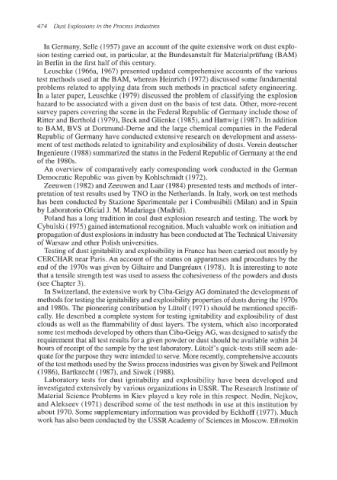Page 507 - Dust Explosions in the Process Industries
P. 507
474 Dust Explosions in the Process Industries
In Germany, Selle (1957) gave an account of the quite extensive work on dust explo-
sion testing carried out, in particular, at the Bundesanstalt fiir Materialpriifung (BAM)
in Berlin in the first half of this century.
Leuschke (1966a, 1967) presented updated comprehensive accounts of the various
test methods used at the BAM, whereas Heinrich (1972) discussed some fundamental
problems related to applying data from such methods in practical safety engineering.
In a later paper, Leuschke (1979) discussed the problem of classifying the explosion
hazard to be associated with a given dust on the basis of test data. Other, more-recent
survey papers covering the scene in the Federal Republic of Germany include those of
Ritter and Berthold (1979), Beck and Glienke (1985), and Hattwig (1987). In addition
to BAM, BVS at Dortmund-Derne and the large chemical companies in the Federal
Republic of Germany have conducted extensive research on development and assess-
ment of test methods related to ignitability and explosibility of dusts. Verein deutscher
Ingenieure (1988) summarizedthe status in the Federal Republic of Germany at the end
of the 1980s.
An overview of comparatively early corresponding work conducted in the German
Democratic Republic was given by Kohlschmidt (1972).
Zeeuwen (1982) and Zeeuwen and Laar (1984) presented tests and methods of inter-
pretation of test results used by TNO in the Netherlands. In Italy, work on test methods
has been conducted by Stazione Sperimentale per i Combusibili (Milan) and in Spain
by Laboratorio Oficial J. M. Madariaga (Madrid).
Poland has a long tradition in coal dust explosion research and testing. The work by
Cybulski (1975) gained internationalrecognition.Much valuable work on initiation and
propagationof dust explosionsin industry has been conducted at The Technical University
of Warsaw and other Polish universities.
Testing of dust ignitability and explosibility in France has been carried out mostly by
CERCHAR near Paris. An account of the status on apparatuses and procedures by the
end of the 1970s was given by Giltaire and Dangrkaux (1978). It is interesting to note
that a tensile strength test was used to assess the cohesiveness of the powders and dusts
(see Chapter 3).
In Switzerland,the extensive work by Ciba-GeigyAG dominatedthe developmentof
methods for testing the ignitability and explosibilityproperties of dusts during the 1970s
and 1980s. The pioneering contribution by Liitolf (1971) should be mentioned specifi-
cally. He described a complete system for testing ignitability and explosibility of dust
clouds as well as the flammability of dust layers. The system, which also incorporated
some test methods developedby others than Ciba-Geigy AG, was designed to satisfy the
requirement that all test results for a given powder or dust should be available within 24
hours of receipt of the sample by the test laboratory. Lutolf’s quick-tests still seem ade-
quate for the purpose they were intended to serve. More recently, comprehensiveaccounts
of the test methods used by the Swiss process industries was given by Siwek and Pellmont
(1986), Bartknecht (1987), and Siwek (1988).
Laboratory tests for dust ignitability and explosibility have been developed and
investigated extensively by various organizations in USSR. The Research Institute of
Material Science Problems in Kiev played a key role in this respect. Nedin, Nejkov,
and Alekseev (1971) described some of the test methods in use at this institution by
about 1970. Some supplementary information was provided by Eckhoff (1977).Much
work has also been conducted by the USSR Academy of Sciences in Moscow. Efimokin

